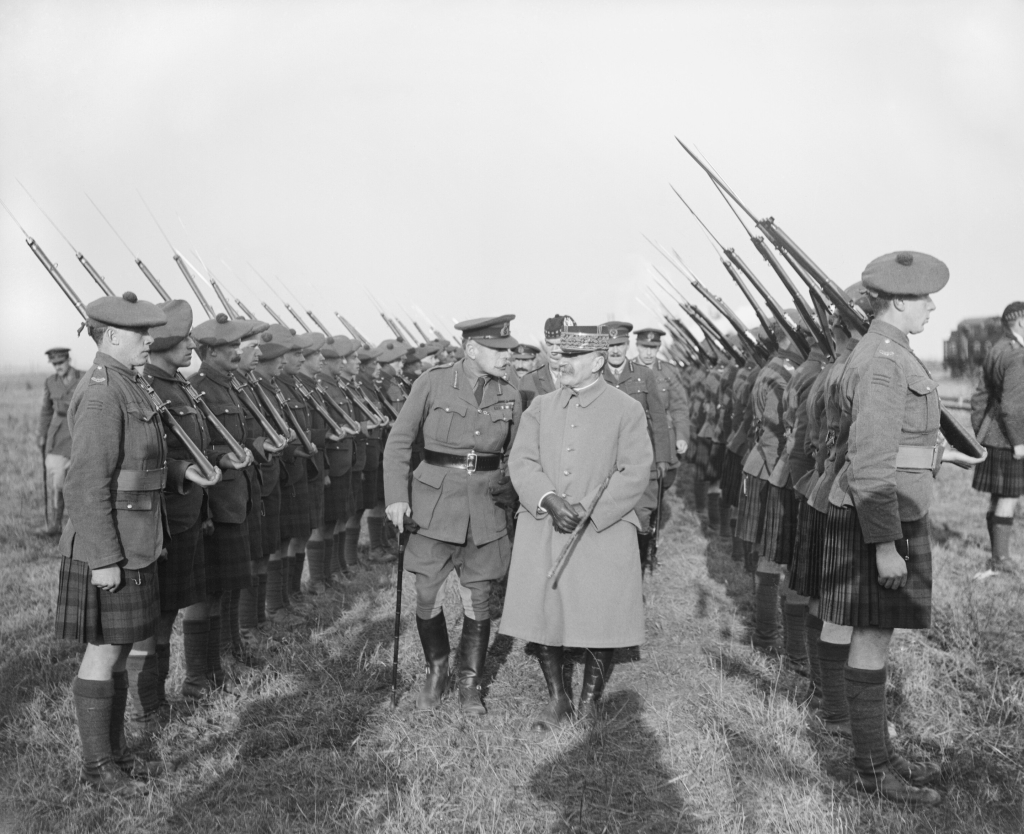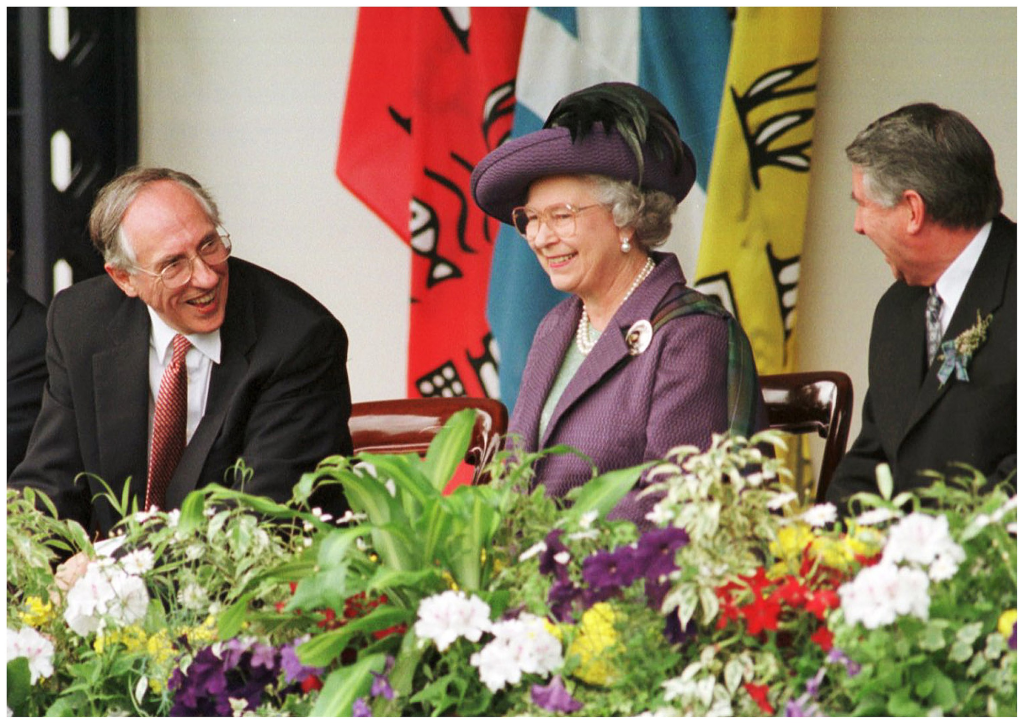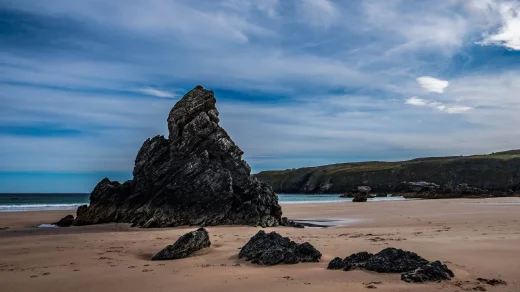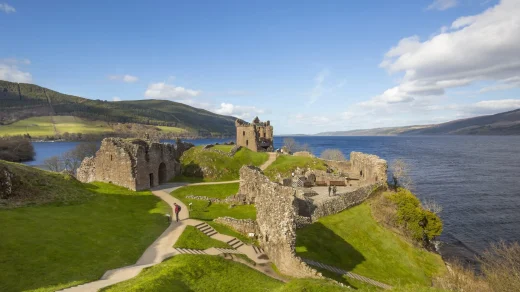Douglas Haig and Ferdinand Foch inspecting the Gordon Highlanders, 1918.

Scotland played a major role in the British effort in the First World War. It especially provided manpower, ships, machinery, fish and money. With a population of 4.8 million in 1911, Scotland sent over half a million men to the war, of whom over a quarter died in combat or from disease, and 150,000 were seriously wounded. Field Marshal Sir Douglas Haig was Britain’s commander on the Western Front.
The war saw the emergence of a radical movement called “Red Clydeside” led by militant trades unionists. Formerly a Liberal stronghold, the industrial districts switched to Labour by 1922, with a base among the Irish Catholic working-class districts. Women were especially active in building neighbourhood solidarity on housing issues. The “Reds” operated within the Labour Party with little influence in Parliament and the mood changed to passive despair by the late 1920s.
The shipbuilding industry expanded by a third and expected renewed prosperity, but instead, a serious depression hit the economy by 1922 and it did not fully recover until 1939. The interwar years were marked by economic stagnation in rural and urban areas, and high unemployment. Indeed, the war brought with it deep social, cultural, economic, and political dislocations. Thoughtful Scots pondered their declension, as the main social indicators such as poor health, bad housing, and long-term mass unemployment, pointed to terminal social and economic stagnation at best, or even a downward spiral. Service abroad on behalf of the Empire lost its allure to ambitious young people, who left Scotland permanently. The heavy dependence on obsolescent heavy industry and mining was a central problem, and no one offered workable solutions. The despair reflected what Finlay (1994) describes as a widespread sense of hopelessness that prepared local business and political leaders to accept a new orthodoxy of centralised government economic planning when it arrived during the Second World War.
During the Second World War, Scotland was targeted by Nazi Germany largely due to its factories, shipyards, and coal mines. Cities such as Glasgow and Edinburgh were targeted by German bombers, as were smaller towns mostly located in the central belt of the country. Perhaps the most significant air-raid in Scotland was the Clydebank Blitz of March 1941, which intended to destroy naval shipbuilding in the area. 528 people were killed and 4,000 homes totally destroyed.
Rudolf Hess, Deputy Führer of Nazi Germany, crashed his plane at Bonnyton Moor in the Scottish central belt in an attempt to make peace.

Perhaps Scotland’s most unusual wartime episode occurred in 1941 when Rudolf Hess flew to Renfrewshire, possibly intending to broker a peace deal through the Duke of Hamilton. Before his departure from Germany, Hess had given his adjutant, Karlheinz Pintsch, a letter addressed to Hitler that detailed his intentions to open peace negotiations with the British. Pintsch delivered the letter to Hitler at the Berghof around noon on 11 May. Albert Speer later said Hitler described Hess’s departure as one of the worst personal blows of his life, as he considered it a personal betrayal. Hitler worried that his allies, Italy and Japan, would perceive Hess’s act as an attempt by Hitler to secretly open peace negotiations with the British.
Royal Scots with a captured Japanese Hinomaru Yosegaki flag, Burma, 1945.

As in World War I, Scapa Flow in Orkney served as an important Royal Navy base. Attacks on Scapa Flow and Rosyth gave RAF fighters their first successes downing bombers in the Firth of Forth and East Lothian. The shipyards and heavy engineering factories in Glasgow and Clydeside played a key part in the war effort, and suffered attacks from the Luftwaffe, enduring great destruction and loss of life. As transatlantic voyages involved negotiating north-west Britain, Scotland played a key part in the battle of the North Atlantic. Shetland‘s relative proximity to occupied Norway resulted in the Shetland bus by which fishing boats helped Norwegians flee the Nazis, and expeditions across the North Sea to assist resistance.
Scottish industry came out of the depression slump by a dramatic expansion of its industrial activity, absorbing unemployed men and many women as well. The shipyards were the centre of more activity, but many smaller industries produced the machinery needed by the British bombers, tanks and warships. Agriculture prospered, as did all sectors except for coal mining, which was operating mines near exhaustion. Real wages, adjusted for inflation, rose 25% and unemployment temporarily vanished. Increased income, and the more equal distribution of food, obtained through a tight rationing system, dramatically improved the health and nutrition.
The official reconvening of the Scottish Parliament in July 1999 with Donald Dewar, then first minister of Scotland (left) with Queen Elizabeth II (centre) and Presiding Officer Sir David Steel (right)

After 1945, Scotland’s economic situation worsened due to overseas competition, inefficient industry, and industrial disputes. Only in recent decades has the country enjoyed something of a cultural and economic renaissance. Economic factors contributing to this recovery included a resurgent financial services industry, electronics manufacturing, (see Silicon Glen), and the North Sea oil and gas industry. The introduction in 1989 by Margaret Thatcher’s government of the Community Charge (widely known as the Poll Tax) one year before the rest of Great Britain, contributed to a growing movement for Scottish control over domestic affairs. Following a referendum on devolution proposals in 1997, the Scotland Act 1998 was passed by the British Parliament, which established a devolved Scottish Parliament and Scottish Government with responsibility for most laws specific to Scotland. The Scottish Parliament was reconvened in Edinburgh on 4 July 1999. The first to hold the office of first minister of Scotland was Donald Dewar, who served until his sudden death in 2000.


